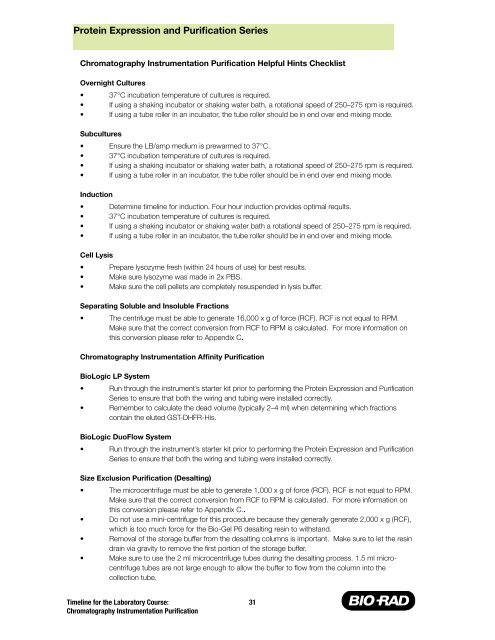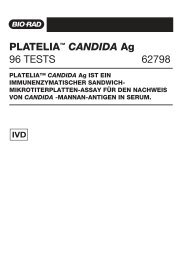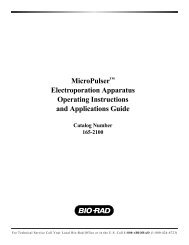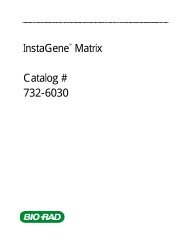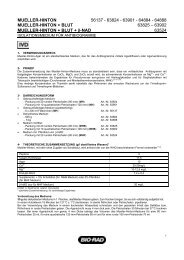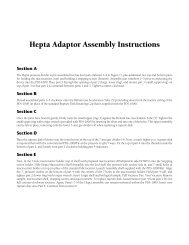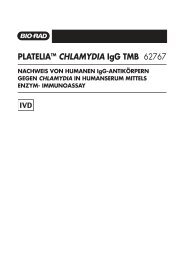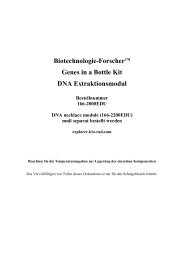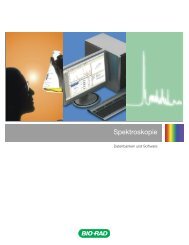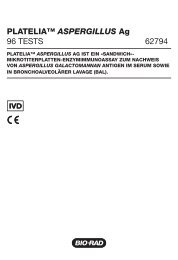Protein Expression and Purification Series - Bio-Rad
Protein Expression and Purification Series - Bio-Rad
Protein Expression and Purification Series - Bio-Rad
You also want an ePaper? Increase the reach of your titles
YUMPU automatically turns print PDFs into web optimized ePapers that Google loves.
<strong>Protein</strong> <strong>Expression</strong> <strong>and</strong> <strong>Purification</strong> <strong>Series</strong><br />
Chromatography Instrumentation <strong>Purification</strong> Helpful Hints Checklist<br />
Overnight Cultures<br />
• 37°C incubation temperature of cultures is required.<br />
• If using a shaking incubator or shaking water bath, a rotational speed of 250–275 rpm is required.<br />
• If using a tube roller in an incubator, the tube roller should be in end over end mixing mode.<br />
Subcultures<br />
• Ensure the LB/amp medium is prewarmed to 37°C.<br />
• 37°C incubation temperature of cultures is required.<br />
• If using a shaking incubator or shaking water bath, a rotational speed of 250–275 rpm is required.<br />
• If using a tube roller in an incubator, the tube roller should be in end over end mixing mode.<br />
Induction<br />
• Determine timeline for induction. Four hour induction provides optimal reqults.<br />
• 37°C incubation temperature of cultures is required.<br />
• If using a shaking incubator or shaking water bath a rotational speed of 250–275 rpm is required.<br />
• If using a tube roller in an incubator, the tube roller should be in end over end mixing mode.<br />
Cell Lysis<br />
• Prepare lysozyme fresh (within 24 hours of use) for best results.<br />
• Make sure lysozyme was made in 2x PBS.<br />
• Make sure the cell pellets are completely resuspended in lysis buffer.<br />
Separating Soluble <strong>and</strong> Insoluble Fractions<br />
• The centrifuge must be able to generate 16,000 x g of force (RCF). RCF is not equal to RPM.<br />
Make sure that the correct conversion from RCF to RPM is calculated. For more information on<br />
this conversion please refer to Appendix C.<br />
Chromatography Instrumentation Affinity <strong>Purification</strong><br />
<strong>Bio</strong>Logic LP System<br />
• Run through the instrument’s starter kit prior to performing the <strong>Protein</strong> <strong>Expression</strong> <strong>and</strong> <strong>Purification</strong><br />
<strong>Series</strong> to ensure that both the wiring <strong>and</strong> tubing were installed correctly.<br />
• Remember to calculate the dead volume (typically 2–4 ml) when determining which fractions<br />
contain the eluted GST-DHFR-His.<br />
<strong>Bio</strong>Logic DuoFlow System<br />
• Run through the instrument’s starter kit prior to performing the <strong>Protein</strong> <strong>Expression</strong> <strong>and</strong> <strong>Purification</strong><br />
<strong>Series</strong> to ensure that both the wiring <strong>and</strong> tubing were installed correctly.<br />
Size Exclusion <strong>Purification</strong> (Desalting)<br />
• The microcentrifuge must be able to generate 1,000 x g of force (RCF). RCF is not equal to RPM.<br />
Make sure that the correct conversion from RCF to RPM is calculated. For more information on<br />
this conversion please refer to Appendix C..<br />
• Do not use a mini-centrifuge for this procedure because they generally generate 2,000 x g (RCF),<br />
which is too much force for the <strong>Bio</strong>-Gel P6 desalting resin to withst<strong>and</strong>.<br />
• Removal of the storage buffer from the desalting columns is important. Make sure to let the resin<br />
drain via gravity to remove the first portion of the storage buffer.<br />
• Make sure to use the 2 ml microcentrifuge tubes during the desalting process. 1.5 ml microcentrifuge<br />
tubes are not large enough to allow the buffer to flow from the column into the<br />
collection tube.<br />
Timeline for the Laboratory Course:<br />
Chromatography Instrumentation <strong>Purification</strong><br />
31


